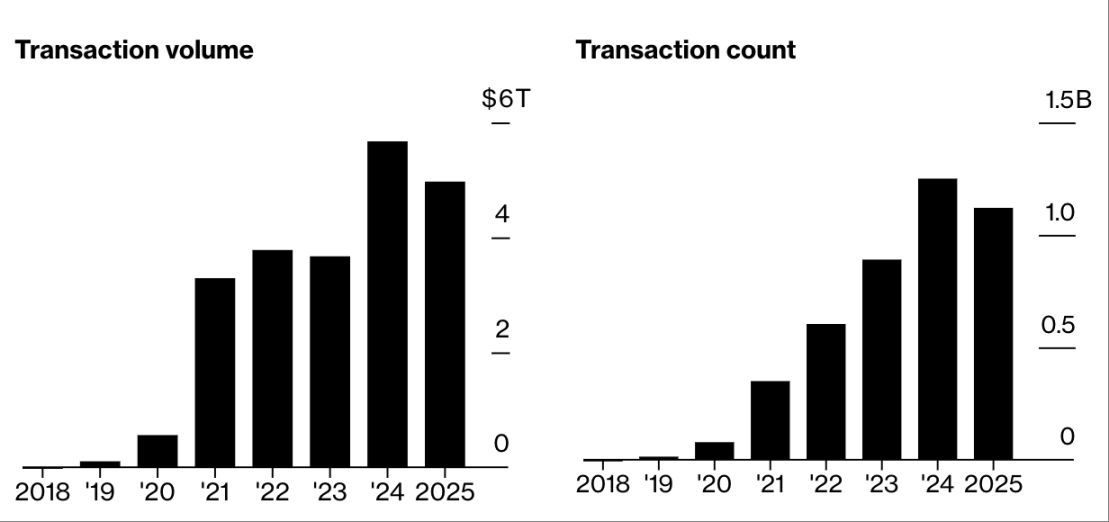"In the cryptocurrency space, some believe that code and technology can solve all problems. But in the foreign exchange field, this idea is too naive."
Written by: Sidhartha Shukla, Bloomberg
Translated by: Saoirse, Foresight News
Key Points of the Article
According to data from Visa and Allium, by 2025, the trading volume of stablecoins has reached $5 trillion, involving 1 billion payments.
When using stablecoins to exchange different fiat currencies, costs similar to conventional exchanges arise, including bid-ask spreads, exchange fees, intermediary costs, and slippage.
Mike Robertson, CEO of foreign exchange infrastructure company AbbeyCross, commented on the limitations of stablecoins as emerging payment tools: "In the cryptocurrency space, some believe that code and technology can solve all problems. But in the foreign exchange field, this idea is too naive."
Despite stablecoins entering a peak period as expected, seasoned professionals in the fintech sector still believe that these tokens have limitations as emerging payment tools.
According to data from Visa and Allium, by 2025, the total trading volume of stablecoins has reached $5 trillion, involving 1 billion payments, which is not far from the total of $5.7 trillion for the entire year of 2024. Since Donald Trump was elected President of the United States in November 2024, the total market value of these cryptocurrencies, which aim to track the prices of mature currencies like the US dollar, has increased by 47%, reaching $255 billion.
The prospects for stablecoins are to bring a faster, lower-cost, and more efficient future to the payment sector, especially in cross-border payments. From the data, this potential is gradually being realized, but there are still doubts about whether this technology can solve long-standing issues that have plagued the foreign exchange business for decades.
When using stablecoins to exchange different fiat currencies (e.g., euros to Hong Kong dollars), many of the same costs as conventional exchanges arise.
"In the cryptocurrency space, some feel that code and technology can solve all problems. But in the foreign exchange field, this idea is too naive," said Mike Robertson, CEO of AbbeyCross. "Each currency has its unique dynamics. Moreover, most banks and payment institutions derive their profits from foreign exchange trading, not from fees."
Stablecoin trading volume is expected to double compared to last year

Source: Visa, Allium
Note: Data for 2025 is as of July
Foreign exchange costs typically include bid-ask spreads, exchange fees, intermediary fees, and slippage. These costs also exist in cross-border cryptocurrency transactions and may be particularly pronounced during the inflow and outflow of funds, which challenges the "low cost" claimed by stablecoin advocates.
The growth in stablecoin payment volume is primarily due to two major application scenarios: one is simplifying cross-border transactions that traditional financial institutions inadequately cover, and the other is payment services in emerging markets.
Startups focused on stablecoin payment infrastructure, such as BVNK, are less concerned with payment channels related to the British pound and the US dollar. According to Sagar Sarbhai, BVNK's Managing Director for the Asia-Pacific region, the company is focusing on "alternative" payment channels, such as payment routes from Sri Lanka to Cambodia.
"These routes typically require multiple intermediaries, which not only incurs high costs but also slows down the process. Stablecoins simplify this process. Although costs may not be low at present, the speed is faster, and the efficiency of fund usage is higher," he stated. Currently, BVNK's annual transaction volume is about $15 billion.
BVNK is not the only startup focused on helping businesses engage in stablecoin operations.
After experiencing a winter in the cryptocurrency industry in 2022, Conduit pivoted to the stablecoin payment sector. This startup began utilizing stablecoins to allow users to remit through local systems like Brazil's Pix and receive payments via SEPA (the Single Euro Payments Area, a standardized payment system covering the EU and some European countries). According to CEO Kirill Gertman, the company's annual processing scale currently reaches $10 billion.
Singapore-based Thunes and Canada's Aquanow are also attempting to collaborate with stablecoin issuers and businesses to simplify payment processes.
"The rise of stablecoins is a business opportunity," said Thunes CEO Floris de Kort, who raised $150 million in April this year. "The infrastructure may change, but people will always need to complete 'last mile' payment delivery using local currencies and wallets."
Venture capitalists reignite interest in stablecoins

Source: CB Insights
Note: Data for 2025 is as of July 23
Compared to the scale of mature payment operators, the above data may seem insignificant. According to Visa's latest annual report, Visa alone processed $132 trillion in payments in 2024, more than double the total trading volume of stablecoins during the same period.
However, the rapid growth of the market has made payment giants highly alert. They are exploring a so-called "stablecoin layer" model: introducing stablecoins between two fiat currencies to bypass traditional banking networks like SWIFT, achieving transaction settlements within minutes, focusing on markets with dollar liquidity shortages and inefficiencies in traditional systems.
In October 2024, Visa launched a platform that allows banks to mint, burn, and transfer tokens backed by fiat currencies, including tokenized deposits and stablecoins.
The recently passed GENIUS Act in the US has provided a clear regulatory framework for the world's largest stablecoin market, allowing banks and payment institutions to enter the field with more confidence. This has triggered a race among global regulators to establish similar regulatory rules for stablecoin issuers.
"We are just beginning to see signs of exponential growth," said Sarbhai of BVNK. "The foundation laid in the past five years may see an explosion in the next 12 months."
免责声明:本文章仅代表作者个人观点,不代表本平台的立场和观点。本文章仅供信息分享,不构成对任何人的任何投资建议。用户与作者之间的任何争议,与本平台无关。如网页中刊载的文章或图片涉及侵权,请提供相关的权利证明和身份证明发送邮件到support@aicoin.com,本平台相关工作人员将会进行核查。




